A Library for visualizing keras neural networks
Project description
Kviz
Visualization library for Keras Neural Networks
pip3 install kviz
Requirements
On Fedora
sudo dnf install python3-devel graphviz graphviz-devel
On Ubuntu
sudo apt-get install graphviz graphviz-dev
Examples
Architecture Visualization
You can visualize the architecture of your keras model as such:
model = keras.models.Sequential()
model.add(layers.Dense(2, input_dim=2))
model.add(layers.Dense(1, activation="sigmoid"))
model.compile(loss="binary_crossentropy")
dg = Visualizer(model)
dg.render()
Produces the following graph:
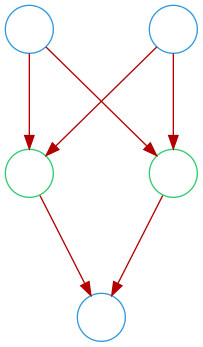
Learning Animation
You can visualize the learned decision boundary of your model as such:
model = keras.models.Sequential()
model.add(layers.Dense(2, input_dim=2, activation='relu'))
model.add(layers.Dense(1, activation='sigmoid'))
model.compile(loss="binary_crossentropy")
# Generate data that looks like 2 concentric circles
t, _ = datasets.make_blobs(n_samples=200, centers=[[0, 0]], cluster_std=1, random_state=1)
X = np.array(list(filter(lambda x: x[0]**2 + x[1]**2 < 1 or x[0]**2 + x[1]**2 > 1.5, t)))
Y = np.array([1 if x[0]**2 + x[1]**2 >= 1 else 0 for x in X])
viz = Visualizer(model)
viz.fit(X, Y, snap_freq=20, duration=300, batch_size=4, epochs=1000, verbose=0)
Which produces the following GIF:
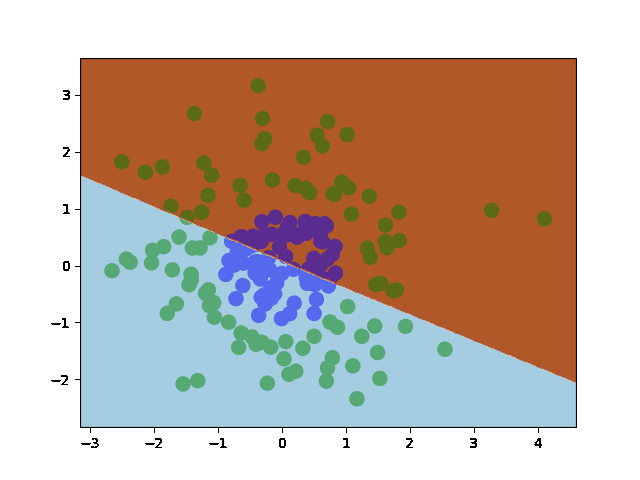
To view the learned decision boundary of your model in the feature space as well, set the view_feature_space flag to True as such: (please note this can only be done for neural networks with one hidden layer)
viz = Visualizer(model)
viz.fit(X, Y, snap_freq=20, duration=300, view_feature_space=True, batch_size=4, epochs=1000, verbose=0)
Which produces the two GIFs side by side:

We can try different activation functions, network architectures, etc. to see what works best. For example, from looking at the GIF we can see that the neural net is trying to learn a decision boundary that is a combination of two straight lines. Clearly this is not going to work for a circular decision boundary. We could expect to better approximate this circular decision boundary if we had more straight lines to combine. We could try changing the number of neurons in the hidden layer to 3 or more (to learn higher dimensional features). This produces the following (for 4 hidden neurons):
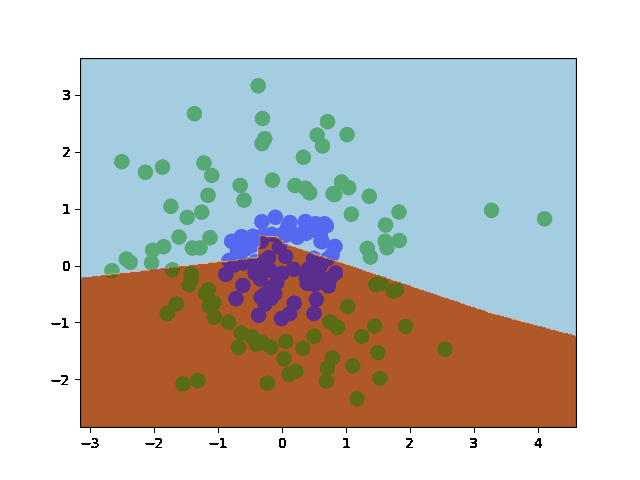
Instead, we can try changing the activation in the hidden layer to a custom_activation
function that is non-linear and matches our intuition of what circles are:
def custom_activation(x):
return x**2
model = keras.models.Sequential()
model.add(layers.Dense(2, input_dim=2, activation=custom_activation))
model.add(layers.Dense(1, activation='sigmoid'))
model.compile(loss="binary_crossentropy")
viz = Visualizer(model)
viz.fit(X, Y, snap_freq=20, duration=300, batch_size=4, epochs=1000, verbose=0)
which produces:
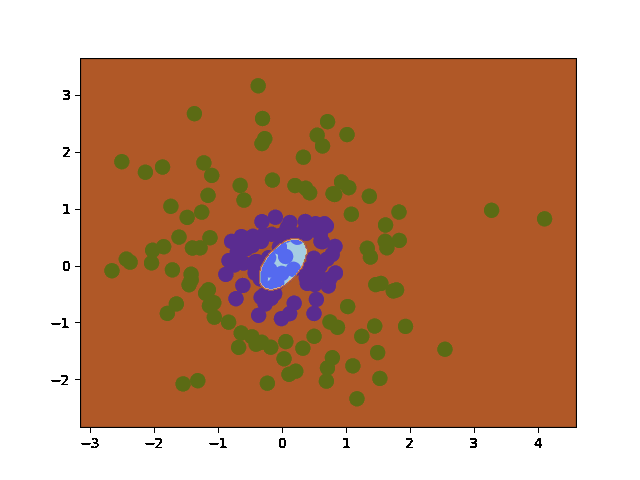
Node Activation Visualization
You can visualize which nodes activate in the network as a function of a set of inputs.
XOR Function
model = keras.models.Sequential()
model.add(layers.Dense(2, input_dim=2, activation='sigmoid'))
model.add(layers.Dense(1, activation='sigmoid'))
model.compile(loss="binary_crossentropy")
X = np.array([
[0,0],
[0,1],
[1,0],
[1,1]])
Y = np.array([x[0]^x[1] for x in X]) # Xor function
viz = Visualizer(model)
viz.fit(X, Y, snap_freq=20, duration=300, batch_size=4, epochs=1000, verbose=0)
viz.view_activations_for(X)
Produces the following decision boundary (visualized using matplotlib):
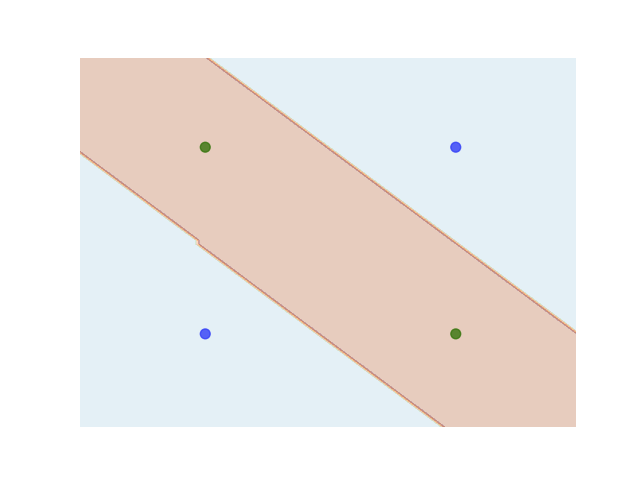
And the following GIF:
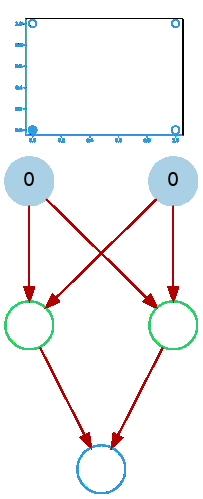
The darker the node the higher the activation is at that node.
Linear Decisions Boundary
import sklearn.datasets as datasets
model = keras.models.Sequential()
model.add(layers.Dense(3, input_dim=2, activation=ACTIVATION))
model.add(layers.Dense(1, activation=ACTIVATION))
model.compile(loss="binary_crossentropy")
centers = [[.5, .5]]
t, _ = datasets.make_blobs(n_samples=50, centers=centers, cluster_std=.1)
X = np.array(t)
Y = np.array([1 if x[0] - x[1] >= 0 else 0 for x in X])
viz = Visualizer(model)
viz.fit(X, Y, snap_freq=20, duration=300, batch_size=4, epochs=1000, verbose=0)
viz.view_activations_for(X)
Produces the following decision boundary (visualized using matplotlib):
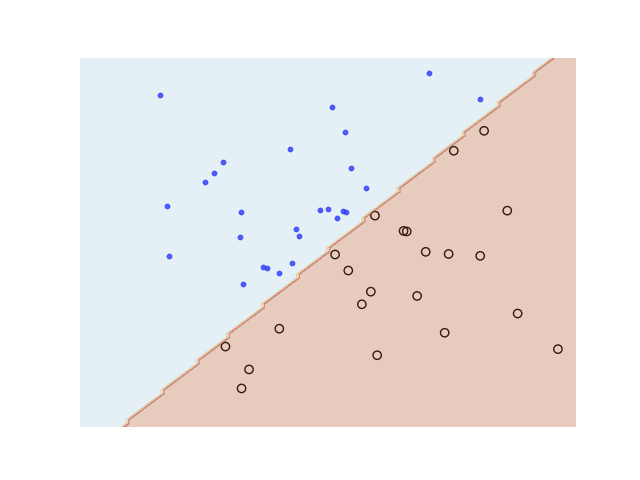
And the following GIF:

At a glance you can see that the activations of the middle hidden node results in predictions of class 0 while the activation of the left-most and right-most hiddent nodes result in predictions of class 1.
Release
Bump the release version in the setup.py file, then run:
make clean
make build
make release
Project details
Release history Release notifications | RSS feed
Download files
Download the file for your platform. If you're not sure which to choose, learn more about installing packages.
Source Distribution
Built Distribution
File details
Details for the file kviz-0.0.12.tar.gz.
File metadata
- Download URL: kviz-0.0.12.tar.gz
- Upload date:
- Size: 13.7 kB
- Tags: Source
- Uploaded using Trusted Publishing? No
- Uploaded via: twine/6.0.1 CPython/3.12.3
File hashes
| Algorithm | Hash digest | |
|---|---|---|
| SHA256 |
f5b71ecffd93d1aacd558fa50a10b0c8239370d36bd5b4ba6bb13e38fabb2b99
|
|
| MD5 |
fece2501cef98cedf3fd61842364751c
|
|
| BLAKE2b-256 |
d8ce0c0da40d4e38b193e4e393ee0089732f517db9bd66d273d75d9b5ad0d77d
|
File details
Details for the file kviz-0.0.12-py3-none-any.whl.
File metadata
- Download URL: kviz-0.0.12-py3-none-any.whl
- Upload date:
- Size: 12.1 kB
- Tags: Python 3
- Uploaded using Trusted Publishing? No
- Uploaded via: twine/6.0.1 CPython/3.12.3
File hashes
| Algorithm | Hash digest | |
|---|---|---|
| SHA256 |
33c13f7e1211d1192f42de1f773357f75993ca94a71f586d4beba70e680a3fd6
|
|
| MD5 |
7c5cdac4962c55211839e2059f86c663
|
|
| BLAKE2b-256 |
e25a6f41b087b9c89f88eec177a42f4fa54b27df293e62b4362984e574ffee19
|













